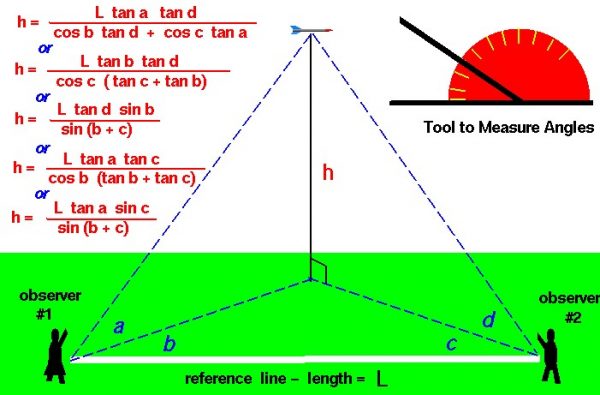Determine Maximum Altitude Interactive

Performance of a Rocket’s Flight
Flying model rockets is a relatively safe and inexpensive way for students to learn the basics of forces and the response of vehicles to external forces. Students can also use math techniques learned in high school to determine the performance of the rocket during the flight.
Maximum Altitude
On this slide we show a simple way to determine the maximum altitude the rocket reaches during the flight. The procedure requires two observers and a tool like the one shown in the upper right portion of the figure to measure angles. The observers are placed some distance L apart along a reference line which is shown in white on the figure. You can lay a string of known length along the ground between the observers. As the rocket passes its maximum altitude, observer #1 calls out “Take Data”, and measures the angle a between the ground and the rocket. This measurement is taken perpendicular to the ground. Observer #1 then measures the angle b between the rocket and the reference line. This measurement is taken parallel to the ground and can be done by the observer facing the rocket, holding position, and measuring from the direction the observer is facing to the reference line on the ground. When the second observer hears the call, “Take Data”, the observer must face the rocket and measure the angle d from the ground to the rocket. The second observer must then measure the angle c, parallel to the ground, between the direction the observer is facing and the reference line in the same manner as the first observer. Angles a and d are measured in a plane that is perpendicular to the ground while angles b and c are measured in a plane parallel to the ground.
Trigonometric Functions
With the four measured angles and the measured distance between the observers, we can use some relations from trigonometry to derive an equation for the altitude h of the rocket. The equation is
\(\LARGE h=\frac{L\tan a\tan d}{\cos b\tan d+\cos c\tan a}\)
where the tangent (tan) and the cosine (cos) are trigonometric functions whose values are determined using tables or a calculator. A detailed analysis of this trigonometry problem indicates that we really only need three angle measurements along with the reference length measurement to completely determine the answer. The angles a, b, c, and d are related to each other and we can eliminate one of the angle measurements and still determine the altitude.
If we eliminate angle a, the resulting equation is determined to be:
\(\LARGE h=\frac{L\tan b\tan d}{\cos c(\tan c+\tan b)}\)
An alternative equation, which is equivalent to the previous equation, is also shown on the figure:
\(\LARGE h=\frac{L\tan d\sin b}{\sin(b+c)}\)
where the sine (sin) is another trigonometric function. Notice that in this equation you have to add the angles b and c before evaluating the sine in the denominator. This is called a “double angle” formula.
If we eliminate angle d, the resulting equation is:
\(\LARGE h=\frac{L\tan a\tan c}{\cos b(\tan b+\tan c)}\)
An alternative equation, which is equivalent to the previous equation, is also shown on the figure:
\(\LARGE h=\frac{L\tan a\sin c}{\sin(b+c)}\)
You can use any of these equations to determine the height of any object from a tall tree to a flying rocket. If you have your observers take all four angle measurements, you can actually make three calculations of the height, which can help to eliminate errors in the measurements. IFf you do not know trigonometry, you can still determine the altitude of the rocket by using a graphical solution from the four angle measurements.
As a further check, here’s a JavaScript calculator which will solve the equations presented on this page.
Please note: the simulation below is best viewed on a desktop computer. It may take a few minutes for the simulation to load.
General Instructions
You can enter the four angles shown in the graphic in the white boxes labeled “Angle A” through “Angle D”. You then choose the mode for the calculation using the drop down menu. Mode #1 uses all four measured angles, Mode #2 ignores angle a, and Mode #3 ignores angle d. You perform the calculations by pushing the red “Compute” button. You should compare all three calculated results, your own hand calculations, and a graphical calculation to determine and minimize errors in the measurements. Calculations and input can be entered in either English or Metric units by using the “Units” choice button.
